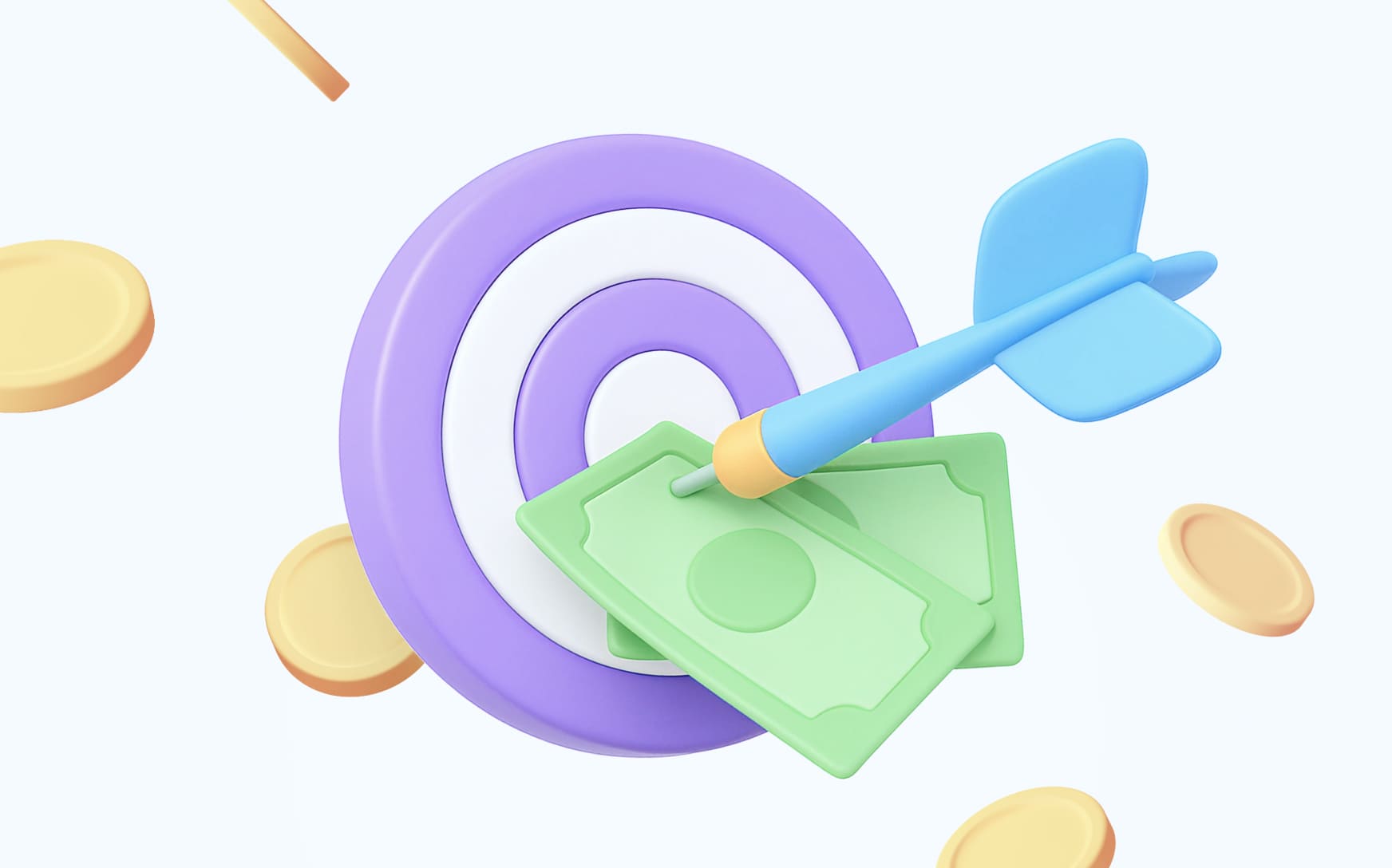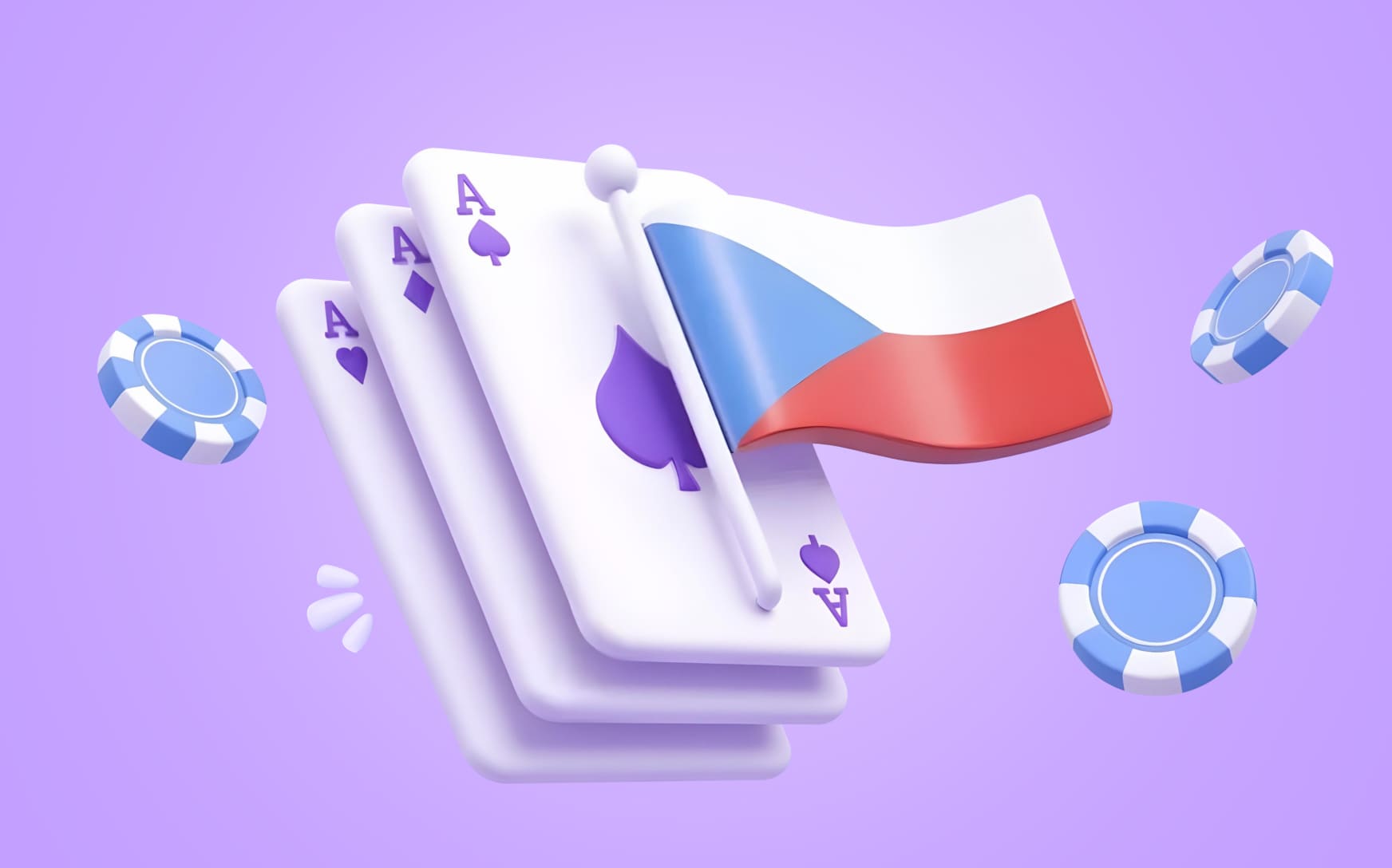Push Advertising
Push notification ads are a unique and powerful ad format in affiliate marketing. They show up as short clickable messages on your device — desktop or mobile — and are sent to users who’ve opted-in to receive them from specific websites or apps. This makes them permission-based and compliant with most global privacy regulations including GDPR.
Let’s break down what push ads are, what they look like and how the subscription process works.

Push Ads Meaning and Definition
At its core, a push notification ad in affiliate marketing is a message delivered via a browser. These ads are sent through the web push protocol (Web Push API) so you can reach users even when they’re not browsing a specific website.
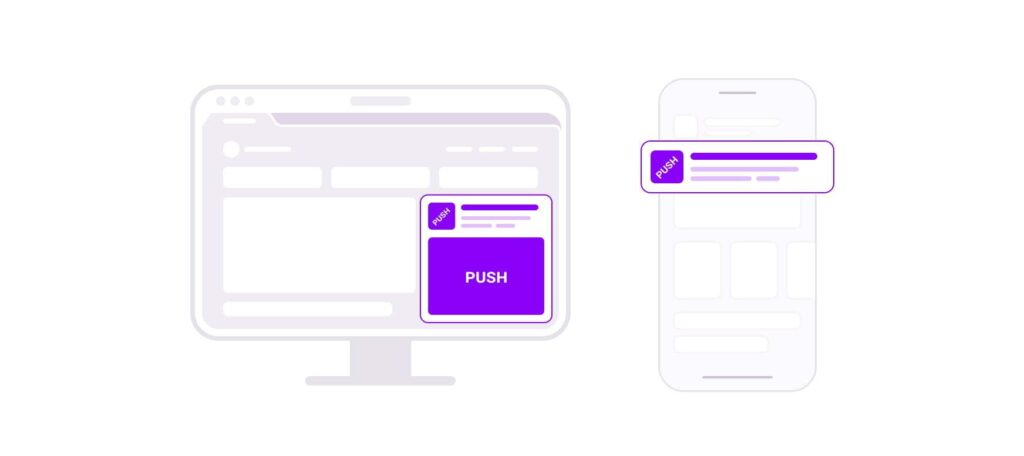
Unlike banners or popunder ads, push notifications appear as native system messages — which makes them non-intrusive and attention-grabbing. They’re sent in real time and land directly on the user’s screen, creating a strong impression with high click-through rates.
What is Push Advertising and What Does “Push Ads” Mean?
From a technical and marketing standpoint here’s a clear push advertising definition:
The term push ads refers to ads that are “pushed” directly to the user’s device via their browser. They don’t require the user to be on a specific website or app at the moment of delivery. Instead, the ad is delivered straight to the user’s screen appearing as a native browser notification.
These ads are built around the concept of real-time user engagement — you’re not waiting for a user to scroll past a banner or open an email. Instead, the message is pushed instantly and lands right where the user is most likely to see it.
This immediacy gives push ads a big edge when promoting time-sensitive offers like gambling tournaments, betting events, product launches or limited time sweepstakes.
What Push Ads Look Like: Structure and Elements
Most push ads follow a simple yet effective structure. Despite the limited number of characters, this format consistently drives results due to its native and clean appearance.
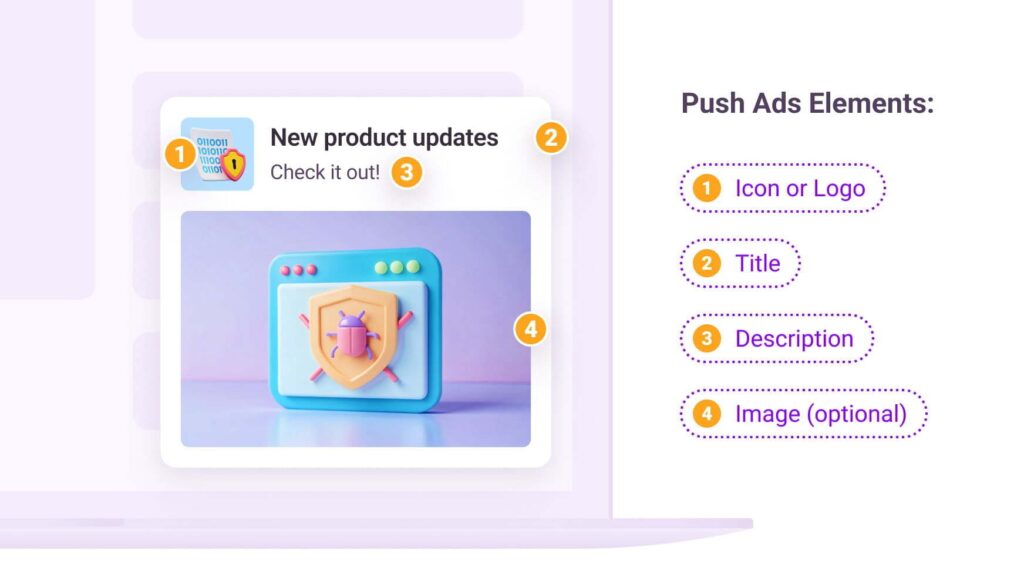
Push Notification Ad Elements:
- Title: Short and attention-grabbing (30-50 characters).
- Description: A few words to provide context or value (up to 100 characters).
- Icon or Logo: 192x192px image that represents the brand or offer.
- Image (optional): A larger image (720x480px) shown on desktop devices.
💡 Note: Unlike banner ads, push notifications are text-forward and optimized for speed — they appear instantly and drive quick decisions from users.
In summary:
Push ads are browser-based notification messages shown to users who have actively subscribed to receive them. These ads appear on both desktop and mobile devices and typically include a short headline, a brief description, an icon, and a clickable call-to-action. The format stands out for its speed, affordability, and global reach, making it one of the most efficient advertising tools in affiliate marketing today.
Why Push Ads Stand Out
So why do affiliate marketers rely so much on push ads in 2025?
First, they blend in with the environment — look like system messages. That’s why they’re less intrusive than banner ads or popunders. Second, they’re highly customizable in terms of look, targeting and timing. And third, they offer global scale — available in every geo and vertical through ad networks like ROIads.
In summary:
Push advertising means real-time browser notifications sent to users who have opted in to receive updates from a website or publisher. These ads don’t require an open webpage to show and work on both desktop and mobile. Because of their native feel and permission-based nature, push ads deliver great engagement and conversion potential — especially for affiliates who need high volume, targeted traffic sources.
How Push Ads Work
Push advertising operates through a systematic process that ensures timely and direct delivery of promotional content to users. Here’s a breakdown of the key components and the workflow involved.
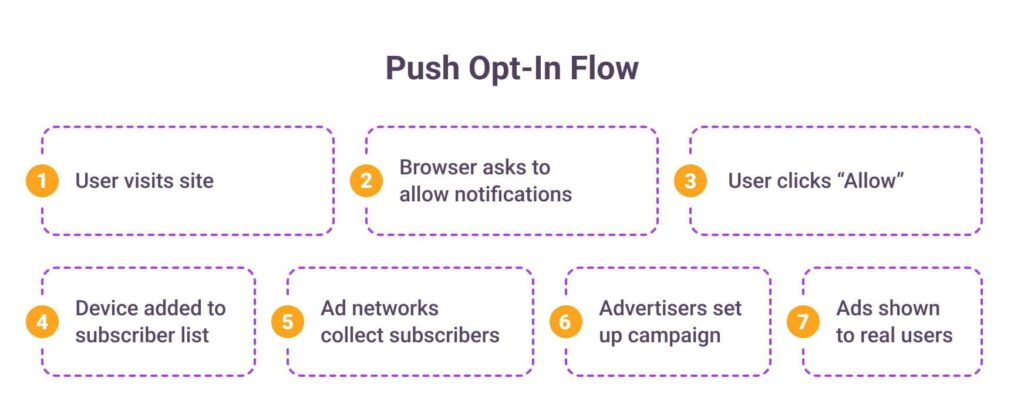
How the opt-in works:
- A user visits a website that has push notifications enabled (via scripts from ad networks or monetization platforms).
- The browser asks the user: “Do you want to allow notifications from this site?”
- If the user agrees, their browser/device ID is saved to a subscriber list.
- This list becomes part of the traffic inventory that ad networks offer to advertisers.
- Advertisers create a campaign → upload creatives → define targeting → and show ads to these real subscribers.
This makes push ads a true opt-in traffic source, meaning users are more likely to engage than with unsolicited formats.
Delivery Mechanism
Once a user is subscribed, the delivery of push ads follows this sequence.

- Campaign Creation: An advertiser creates a push notification campaign, writing the message, choosing the image, and selecting the target audience based on various parameters like location, device type and user behavior.
- Ad Network Distribution: The campaign is sent to an ad network which distributes the push notifications to a large network of subscribed users across multiple publisher sites.
- Real-Time Sending: When the campaign is live, the push notifications are sent in real-time to the devices of users who have opted in, regardless of whether they are currently browsing the website.
- User Interaction: The notification appears on the user’s device and they can choose to engage with it by clicking which redirects them to the advertiser’s landing page or offer.
- Performance Tracking: Advertisers track the performance of the campaign through metrics like delivery rates, click-through rates (CTR) and conversions and can optimize accordingly.
Types of Push Ads
If you already know what push notification ads are, the next step is understanding which type to use for your goals. Each push format has its own mechanics, advantages, and ideal use cases. Here are the main types supported by ad networks.
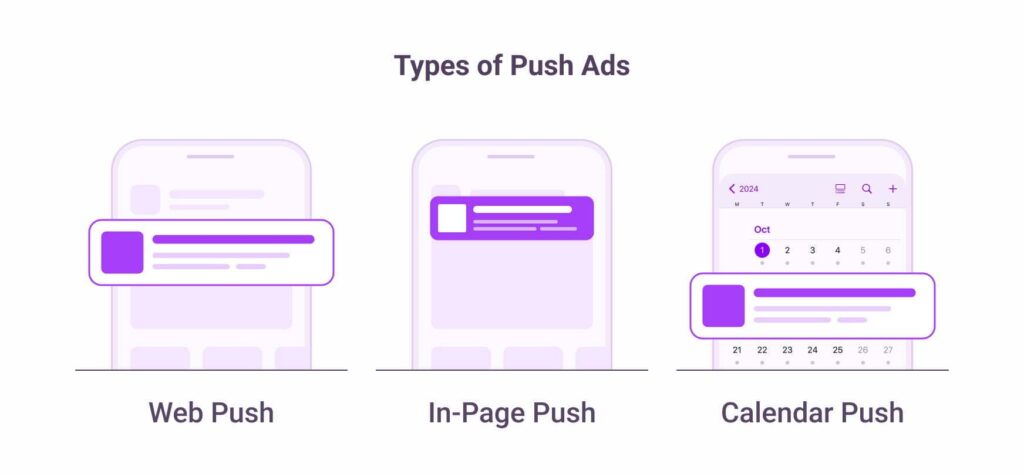
1. Web Push Notifications
These are traditional push notifications sent through web browsers to users who have opted in. After subscribing to receive notifications, users start receiving messages even when they are not actively visiting the website. Web push ads appear as system-like alerts and are supported on both desktop and mobile (mostly Android).
Best for: Broad reach, general performance, classic push campaigns.
2. In-Page Push Ads
In-page push (also known as floating push ads) are displayed directly on a website’s page content while the user is actively browsing. The main difference is that no subscription is required — the user doesn’t need to click “Allow” to see them. This makes in-page push a good alternative for browsers and devices that don’t support traditional push formats (like iOS).
Best for: Mobile traffic, extra coverage, additional monetization.
3. Calendar Push Ads
Calendar push is an alternative push format that sends promotional messages through the user’s native calendar app. Once subscribed, users receive scheduled event reminders that appear as standard alerts — even when they’re offline or not using a browser. This format is supported on both Android and iOS, so it’s a great way to reach iPhone and iPad users who are otherwise not receiving classic web push notifications.
Best for: Unsubscribed segments, mobile alerts.
Advantages of Push Ads
- Immediate Reach: Push notifications are delivered instantly, ensuring that users receive timely information or offers.
- High Visibility: Appearing directly on the user’s device screen, push ads are more likely to capture attention compared to traditional ad formats.
- User Engagement: Since push ads are permission-based, they are sent to users who have expressed interest, leading to higher engagement rates.
- Cross-Device Compatibility: Push ads can be delivered across various devices, including desktops, tablets, and smartphones, enhancing reach and flexibility.
Understanding the operational workflow of push ads enables affiliate marketers to leverage this format effectively, ensuring that promotional messages are delivered to a receptive audience in a timely and engaging manner.
Top Geos for Push Advertising in 2025 Based on ROIads Data
Push ads performance often depends on the right geo. Some geos have high traffic volume and low CPC, others bring in premium leads with stronger purchasing power. Based on internal data from ROIads, here are the top countries for push campaigns in 2025.
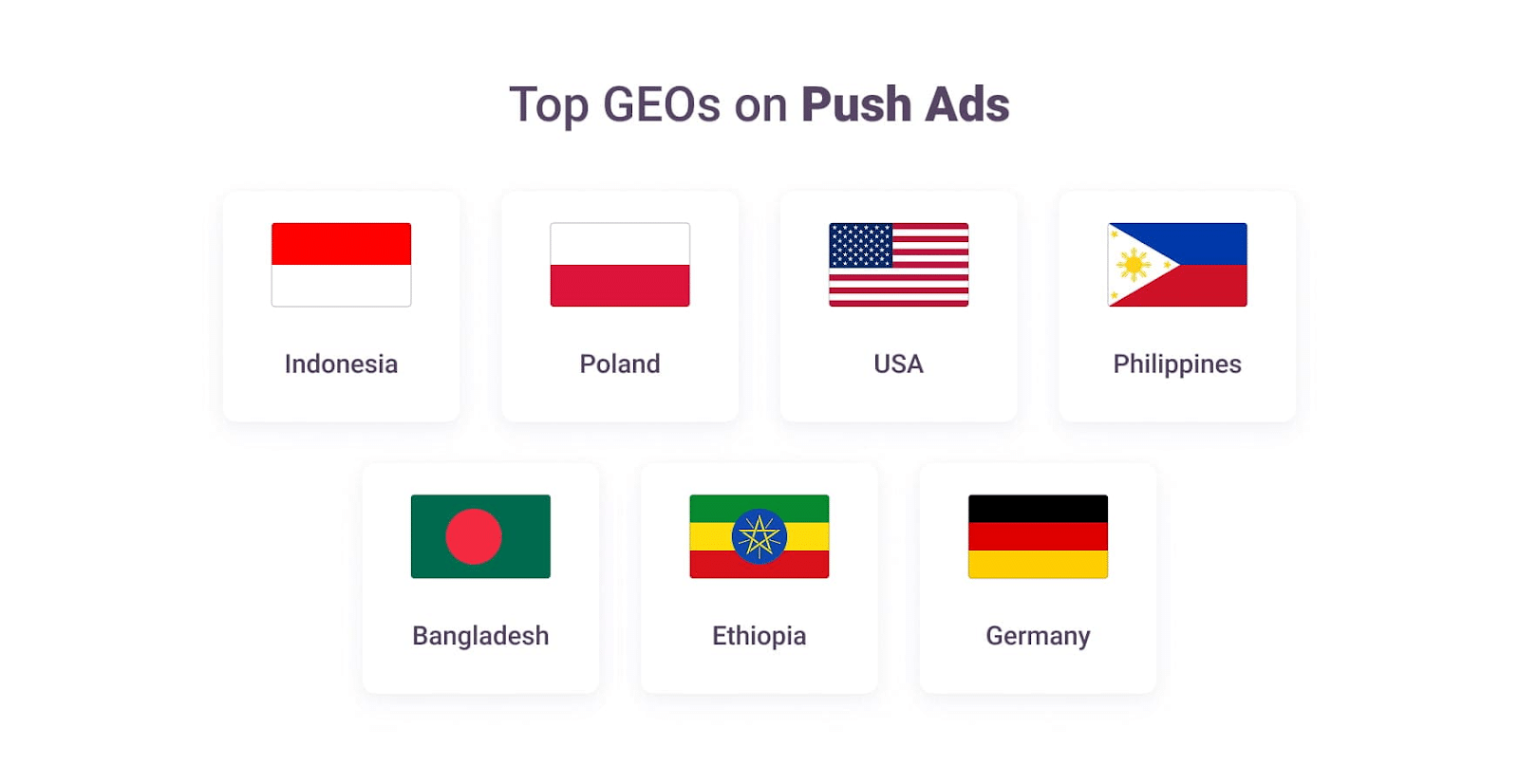
These geos deliver high impression volume and good performance across popular verticals like gambling, betting, finance, utilities.
| Geo | Impressions per Day | Average CPC |
| Indonesia | 122,179,316 | $0.05 |
| Poland | 14,787,556 | $0.05 |
| USA | 31,031,121 | $0.12 |
| Philippines | 8,933,321 | $0.01 |
| Bangladesh | 97,841,546 | $0.07 |
| Ethiopia | 5,266,506 | $0.04 |
| Germany | 58,587,522 | $0.10 |
Each geo has its own traffic profile. Indonesia and Bangladesh have incredible reach at competitive CPC, perfect for scaling volume-driven verticals like gambling and utilities. USA and Germany have higher costs but attract high value users in finance, antivirus, sweepstake campaigns.
In summary:
ROIads has strong push traffic in key global regions. Indonesia, Bangladesh, Philippines are top picks for cost efficient scaling, USA and Germany for higher ticket offers. Poland and Ethiopia are in between CPC and conversion potential, so affiliates have a flexible starting point for testing and optimization.
Top Verticals for Push Ads at ROIads
Push advertising is one of the most versatile and scalable traffic formats in affiliate marketing. It’s non intrusive, high converting and works on many offers. But to really maximize ROI you need to match the right vertical with the right device — mobile or desktop.
Whether you’re running broad reach campaigns or niche offers, here’s a breakdown of the top performing verticals for push traffic by device.
Mobile Push: Top Verticals
Mobile push ads are known for their massive reach and real time engagement. They appear directly on users’ smartphones, making them perfect for impulse driven actions. Based on campaign data from ROIads ad network, here are the top verticals for mobile push.

- Gambling — Mobile users interact with gambling ads a lot, especially when the creative is dynamic and visually appealing. Great for registrations and deposits.
- Betting — Sports betting offers perform well on mobile, traffic peaks around live events, matches and tournaments.
- Finance — Financial offers like quick loans, investment apps and wallet solutions perform well, especially with time sensitive or localized messaging.
- mVAS — Mobile value added services like ringtone subscriptions, video content or mobile games see great results with frictionless flows and direct carrier billing.
Desktop Push: Top Verticals
Desktop push traffic is generally more stable and has higher retention rates. It works well for offers that require more attention or a deeper decision making process. On ROIads the following verticals perform best.

- Antiviruses — With digital safety on the rise antivirus software performs exceptionally well, especially with urgency driven creatives.
- Software & Apps — Utility software like cleaners, VPNs and optimization tools do well on desktop as there’s more space for informative and tech oriented creatives.
- Gambling — Desktop still performs well for gambling offers, especially in markets where users prefer larger screens for gameplay or sign up flows.
- Dating — Long form dating offers convert better on desktop, users are more likely to read and explore the content before engaging.
Real-World Examples: Push Ads Campaigns on ROIads
Push traffic isn’t theory — it’s practice. Here are three real case studies from ROIads advertisers that show how affiliate marketers launch, optimize and scale push ad campaigns across verticals and geos. Each one shows how the right targeting, offer and strategy can generate real profits — even in competitive niches.
Gambling Campaign in Azerbaijan: 3X ROI with Push Traffic
This case is about a gambling offer promoted in Azerbaijan using push notifications. The advertiser tested multiple strategies — Whitelist traffic and device segmentation. Thanks to precise targeting and Micro bidding, the campaign made over 3X ROI with smart scaling.
Finance Offer in Mexico: $2.4K Profit with PEMEX Campaign
A media buyer launched a push campaign for a finance offer linked to PEMEX — a Mexican state oil company. By testing creatives with national identity and source-level optimization, the campaign made $2,400 in profit. Key tools: whitelist, fresh subs and ROIads AI bidding technology.
Finance Vertical Success: $660 Profit in Just 5 Days
This case is about a high-converting finance offer where the advertiser split traffic by freshness, tested aggressively on creatives and used Micro bidding rules to scale the top-performing sources. In under a week the campaign made $660 in profit with 200+ conversions.
Common Mistakes to Avoid in Push Campaigns
Even seasoned media buyers can lose money on push ads if they skip the fundamentals. While the format is easy to launch, real performance comes from knowing what not to do. Below are the most common mistakes affiliates make with push traffic — and how to avoid them.
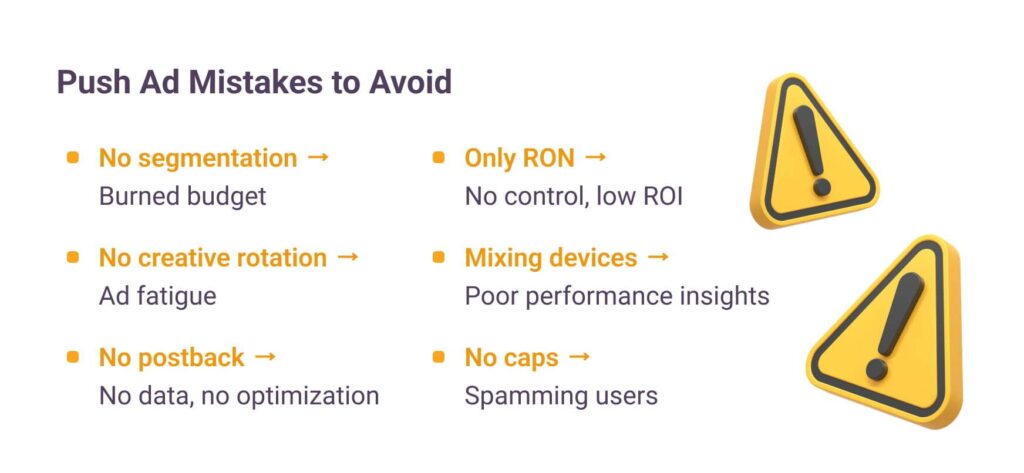
1. Launching Without Segmentation
The biggest mistake is running a campaign with too broad targeting — all countries, all devices, no filtering. This burns the budget fast. Always segment by geo and device from the start. Push works best when it’s laser-focused. But don’t go too narrow right away either — avoid over-restricting your targeting during the testing phase. Start with smart segmentation, but keep it wide enough to gather data, then narrow down during optimization based on performance.
2. Ignoring Creatives Rotation
Push users suffer from ad fatigue quickly. If you run the same creative for days, your CTR drops and CPC rises. Always test 5–10 creatives per campaign and rotate them based on performance.
3. Skipping Postback Setup
Without postback tracking, you’re flying blind. You won’t know which clicks brought conversions — and won’t be able to optimize bids or use automated rules. Set up server-to-server (S2S) tracking before launching.
4. Using Only Run-of-Network (RON)
Running traffic across the entire network (RON) can be a great way to test, but scaling requires more control. Use whitelists, blacklists and Micro bidding to fine-tune sources — especially if ROI starts dropping.
5. No Frequency or Click Cap
Push is powerful, but overexposure kills performance. Always set frequency caps (e.g. 1-2 impression/user/day) and click caps to avoid spamming users and wasting budget.
6. Underestimating Desktop vs Mobile Behavior
Push ads perform differently on desktop and mobile. Don’t mix desktop and mobile in the same campaign — test and optimize them separately to understand which converts better.
Best Push Creatives for Top Verticals in 2025
Looking for inspiration? We’ve collected the most effective push ad creatives across all major verticals of 2025 — including Gambling, Betting, Dating, Finance, Antivirus, and more.
Check out real examples with proven performance in our dedicated guide:
Want to find even more winning creatives? Explore the best spy tools for push traffic and see what’s working for top affiliates right now:
These resources will help you launch better campaigns faster — based on what actually converts.
Are Push Ads Still Worth It in 2025?
Absolutely — push advertising is still worth it in 2025. Despite growing competition and new formats entering the scene, push is one of the most stable and scalable traffic sources in 2025.
Its biggest strengths are simplicity and speed. With just a few creatives and a properly configured campaign, affiliates can reach millions of users across the globe in real time — on both desktop and mobile.
At ROIads, we see hundreds of successful campaigns every month across verticals like gambling, finance, dating and antivirus. From Tier 1 to Tier 3 geos, push traffic delivers ROI — especially for those who test and optimize.

